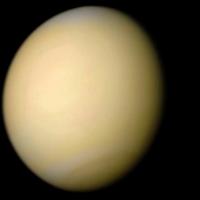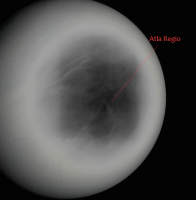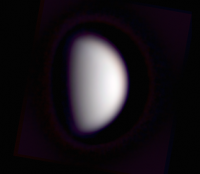Printable Version of Topic
Click here to view this topic in its original format
Unmanned Spaceflight.com _ Venus _ Messenger Venus flyby images
Posted by: Gladstoner May 29 2015, 09:14 PM
Regarding the few images released after the 6/5/2007 Messenger flyby of Venus:
http://photojournal.jpl.nasa.gov/catalog/PIA10124
The image caption states that 614 images were acquired. Are these available?
After all these missions, there is still a lack of (available) visible-light (non-UV) images of the 2nd rock.
Posted by: Bjorn Jonsson May 29 2015, 09:29 PM
Yes, they are available - all of the Messenger images are released through the PDS imaging node: http://img.pds.nasa.gov/
Visible light images are (almost) completely featureless with the exception of violet images so they aren't that useful.
Posted by: Gladstoner May 30 2015, 12:54 AM
Visible light images are (almost) completely featureless with the exception of violet images so they aren't that useful.
Thank you. Unfortunately, there doesn't appear to be any full-disk views there, unless a mosaic can be assembled from the close-ups.
In any case, I've always wanted a photo/image of Venus as our eyes would see it in person. I hope a future spacecraft using Venus for a gravity assist could snap a few photos.
Posted by: dvandorn May 30 2015, 01:07 AM
The best one I've seen is this Mariner 10 attempt at a true-color image from its Venus flby. It was produced by Ricardo Nunes from Mariner's clear and blue filters.
Here's the URL for this and other Mariner 10 images by him:
http://www.astrosurf.com/nunes/explor/explor_m10.htm
-the other Doug
Posted by: elakdawalla Jun 1 2015, 04:28 PM
That version did not correct for the nonsquareness of the pixels, so looks oval (and yellow). I like http://www.planetary.org/multimedia/space-images/venus/global-view-of-venus-from.html. Also, http://www.planetary.org/multimedia/space-images/venus/venus_messenger_3447783055_7201387b94_o.html.
Posted by: 4throck Jun 1 2015, 10:12 PM
That orange version is some derivative of my original image.
The original shows a gibbous Venus (Mariner 10 doesn't have that much distortion, the camera system is similar to Voyager's) and colors closer to Malmer's version.
Mariner color data comes from Clear and Blue filters only.
I subtracted the Blue data from the Clear (panchromatic) channel, thus creating a synthetic yellow chanel.
Some interesting results also come from Venus Express ( http://www.astrosurf.com/nunes/explor/explor_vex.htm ):
I feel that all those images hold up quite well.
Some overall brightness and color variations are visible.
The general tone is yellowish, but it depends a lot on the actual processing, image gamma etc.
Posted by: Gladstoner Jun 2 2015, 02:48 AM
Thanks everyone for the images and links. But this:
is a gorgeous view of the planet. This isn't merely one of the many false-colored treatments and renderings I've seen throughout my life. This looks as if one is seeing Venus in person through a porthole in all its blank, yet spectacular and real glory. The understated appearance makes the planet even more mysterious and foreboding.
Too bad the globe doesn't fit within the frame. I may try to reconstruct the missing parts in a photo editor.
Posted by: ZLD Jun 2 2015, 05:16 AM
Interesting. I hadn't seen that Messenger image myself. Had any comment been made about ground visibility with that image? Fascinating!
I also would like to note the interesting linear clouds towards the upper left of the dark region. Would be nice if that were smoke.
Here's the same image with the primary set to negative
http://i.imgur.com/AJEv47L.jpg
Edit: clarity
Posted by: 4throck Jun 2 2015, 08:36 AM
You can't see the surface in visual wavelengths.
The "atmospheric windows" are on the IR bands.
To view details on the clouds, simply use images on the UV band. Much better than trying to process visible images.
An interesting mission for that was Pioneer Venus.
I've tried to put together a small image library of full disk UV images:
http://www.astrosurf.com/nunes/explor/explor_pvenus.htm
On this case there might be some geometric distortion, since the "camera" was a Photopolarimeter, just like on P10 and P11.
Posted by: Phil Stooke Jun 2 2015, 05:07 PM
As 4throck says, that image is not showing the surface.
If somebody wanted to convince me otherwise, I would want to know exactly which part of the planet was facing the spacecraft at that time. A general resemblance to one small feature is not nearly enough.
Sorry!
Phil
Posted by: tasp Jun 2 2015, 05:37 PM
Very much appreciate the Messenger color Venus picture, Emily. The sharp edge of the limb emphasizes the featurelessness nature of the upper cloud deck very effectively. If there was something to see, it would be there.
Thanx very much for all your help here.
Posted by: JRehling Jun 2 2015, 06:31 PM
Here's my best image of Venus, taken with a Celestron 6se last month:
Amateurs have turned up some very impressive results in UV and IR, but in visible light, there's not much difference between so-so, pretty good, and the best efforts.
I've played around with projecting this into a map, then projecting the map back into a sphere to create a full Venus image, but one has to make a good model with Hapke parameters to do that right. And then, you could get a nice full Venus image. Which, to spoil the surprise, is going to be a white circle. You may as well take a Voyager image of Uranus and desaturate the color away and you'll get almost the same result.
Posted by: 4throck Jun 2 2015, 06:46 PM
Nice image!
Again I agree. You can get good earth based images of Venus. Measure of quality is sharpness of the limb.
For that you should image when the planet is high, during the day :-)
Posted by: ZLD Jun 2 2015, 08:43 PM
Not intending to be stuck on this but I do find the prominence of the lines interesting. I've never seen any other images of Venus with similarly sharp features present, beyond radar data. Does any one know what files this composite comes from in the PDS? It would be very helpful to know the time they were captured at least.
Also, my Venus geology is poor and when I previously notated Alta Regio, I intended Beta Regio. I'm not sure of the path that Messenger took past Venus, but if it was actually slightly above the ecliptic, and the shadowed limb is actually around the northern pole (as the clouds seem to allude to), the features could (and I emphasize that strongly in ignorance here) place the feature very near Beta Regio.
http://i.imgur.com/DIBflYF.gif
Click to animate
Posted by: JRehling Jun 2 2015, 10:13 PM
Here, an amateur used IR to image Venus's night side. Whether or not surface features are visible, I'm not sure.
http://www.skyandtelescope.com/astronomy-news/amateur-images-venuss-surface/
Galileo used IR to map Venus topography - not leading to any useful improvements on the mapping of the planet, I don't think, but rather a nice demonstration that it's possible. Then Venus Express certainly improved on that work, collecting possible evidence of an active volcano.
http://sci.esa.int/venus-express/46816-surface-warmth-on-a-volcano-on-venus/
Posted by: 4throck Jun 3 2015, 09:56 AM
There are frequent "linear" cloud features on Venus. Specially visible around the polar regions.
As far as I know, atmospheric studies (including ground based) only determined a recurrent Y shaped cloud pattern, and a ~4 days rotation period.
No other permanent features were noted. And since Venus rotates slowly, any localized persistent phenomena would be noticed.
On the IR the surface emits (heat) so you can measure that (with some degree of blocking from the clouds). But essentially you get topography/surface temperature, not albedo.
Here's an interesting link:
https://astro.uni-bonn.de/~dfischer/venus/
Posted by: Phil Stooke Jun 3 2015, 02:14 PM
If you like those linear features, you'll love these! Venus by Percival Lowell, 1896:
http://www.skyandtelescope.com/wp-content/uploads/spokes_l.jpg
Phil
Posted by: JohnVV Jun 3 2015, 09:24 PM
the lack of details in the "Human visible" and the over all unidirectional flow in the UV
is the reason i use a 100% synthetic ( fractal based ) cloud map for Venus
the Pioneer Venus images in PDS
http://pds-atmospheres.nmsu.edu/Venus/venus.html
and on
http://www.astrosurf.com/nunes/explor/explor_pvenus.htm
are great ,-- but rather OLD
Posted by: ZLD Jun 3 2015, 10:17 PM
By golly, Lowell has been redeemed! I see those lines exactly!
Posted by: JRehling Jun 4 2015, 05:02 PM
I suspect that with the right filters, some details on Venus would be visible to a human observer appropriately located, but a human looking at Venus from nearby with no filters at all would be on the verge of pain from the intense brightness. I suppose you could simulate it by using a mirror to reflect sunlight onto something white on a bright, sunny day so that there was a spot with double sunlight. It's bad enough looking at snow on a sunny day, and Venus sunlit clouds are about twice as bright.
But, there is contrast at the violet end of the spectrum, just barely in the visible range, and so a person with the right "sunglasses" could see detail. But without those, the SNR would be problematic due to the greater luminance in the rest of the spectrum. And, as I mentioned above, it would be somewhere between blinding and painful.
It might be interesting to consider what polarizing filters could achieve. When I'm wearing sunglasses, I often see sun dogs in the sky and notice that without the shades, the sun dog is essentially invisible.
Posted by: 4throck Jun 4 2015, 05:31 PM
Lowell was too creative on his drawings and interpretations.
On that illustration he was seeing the Y shaped pattern, and that is real.
But he interpreted the shadings as linear features, and put those into the sketch.
As always, one should never over interpret low SN data :-)
Powered by Invision Power Board (http://www.invisionboard.com)
© Invision Power Services (http://www.invisionpower.com)



